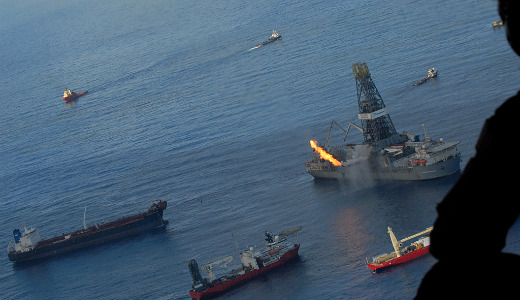
Gulf Coast residents are not jumping for joy over BP’s claim today that it is close to placing a new tight cap that could finally stop or cut the flow of oil gushing from its damaged well. They are wary after what they see as months of failed efforts by BP to stop the spill and continuing attempts by the company to downplay the damage already done to the Gulf and to the fishing, tourism, shipping and other industries.
“At this point, there have been so many ups and downs that everyone here is saying, ‘we’ll believe it when we see it’,” said Keith Kennedy, a charter boat captain who works out of Venice, La.
Along the docks near Brad Robin’s oyster business in Yscloskey, La., the crab traps remain unused, stacked up in a big pile for months now. The trailers opposite the traps, normally rented out for the season, are empty.
“The oil is out in the Gulf and washing up in the estuaries. It could be there for many years,” Robin said. “There will be no return to normal as long as the oil is there and the fear we have is that this is the kind of thing from which there might never be a recovery.”
in a Monday press briefing BP Chief Operating Officer Doug Suttles said, “We have the cap very close, and later today we’ll be attaching it,” He said that at least 48 hours of testing would be needed to see if the new cap works.
The well has been gushing completely unchecked since an old, leaky cap was removed from the wellhead on Saturday. Suttles said that if, after the new cap is in place, “we get lower pressure readings it could mean there are leaks elsewhere in the well. In that case, we will work to collect the leak with surface vessels and by dropping another cap on top of this one.”
At first BP said it could stop the flow with a giant concrete box over the well. When that failed it pumped mud and refuse into a pipe and when that failed it tried siphoning the oil. The next effort was to convert a supertanker on the surface into a giant skimmer and now the company is trying placement of the new caps.
BP says that even if the cap works the final fix will not come until one of the relief wells reaches the leaking well from underground. The plan is to inject heavy drilling mud and cement to form a permanent seal. The company is actually drilling two relief wells, the second one demanded by the Obama administration, in case the first one fails. BP says the first relief well will be done in August. Environmentalists have said that a process of trial and error could delay completion for additional months, however.
“The BP rep told me that they didn’t really know how long this would take. He said it could be seven weeks, seven months or seven years,” said David Dixon, a shrimp boat captain in St. Bernard parish whom BP has enlisted for cleanup work. Dixon spoke with a company representative when he went for his intiial training as part of the cleanup crew.
Louisiana officials say they expect oil to continue washing up on the shores for months after the leak is sealed, meaning an extended cleanup period.
Business is way down, says Vicki McVey, the bartender at Artie’s Sports Bar in Grand Isle, La., where every local fishing tournament has been cancelled. “The damage has already been done,” she said.
Photo: A member of the Coast Guard flying over the Gulf of Mexico July 4 gazes down at vessels stationed over the BP Deepwater Horizon oil spill site. U.S. Army photo by Spc. Stephanie Cassinos.












Comments